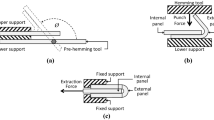Abstract
The residual clearances after pre-joining the panels directly affect the subsequent processes with the automatic drilling and riveting machine, so that these clearances could be used a criterion of pre-joining processes. Moreover, the pre-joining process model for single panel based on clearances criterion is not applicable to determine the processes for batches of panels, which leads to the non-identical pre-joining parameters for every panel, the inconvenient operations for workers, the huge measurement workload of clearances, and the low assembly efficiency. To solve the aforementioned problems, this paper proposes a pre-joining process planning model for a batch of panels based on statistical clearances. The proposed model takes both the stiffness matrices of key points of panels and the measured distribution parameters of sample of initial clearances as an input, regards the weighted sum of mean and variance of residual clearances after pre-joining as an evaluation criterion, thinks the pre-joining parameters adapted to all panels including the number, location, and sequence as an objective, employs the random Bezier curves to fit the clearance distributions of key points of panels and applies the method of Latin hypercube sampling to simulate processes rapidly. Hence, this model may be used to exponentially reduce both the number of degrees of freedom of nodes and the number of statistical simulation, widely adapt the differences of clearance distributions of panels, quickly determine the standardized parameters of pre-joining process and dramatically improve the assembly efficiency. Lastly, the model has been verified with an example consisting of 30 pairs of skin–stringers with the same configuration.
Similar content being viewed by others
References
Zhou JQ, Chen GL, Lai XM, Lin ZQ (2007) A genetic algorithm to process-oriented optimization of joint configuration based on a skeleton model. Int J Adv Manuf Technol 32(11–12):1245–1252
Agnetis A, Macchiaroli R (1998) Modelling and optimization of the assembly process in a flexible cell for aircraft panel manufacturing. Int J Prod Res 36(3):815–836
Saadat M, Cretin L, Sim R, Najafi F (2009) Deformation analysis of large aerospace components during assembly. Int J Adv Manuf Technol 41(1–2):145–155
Li Y, Cheng H, Zhang KF (2012) GAAA-based layout method of locating points for aero thin-walled structure automated riveting. Adv Mater Res 433:489–496
Li XG, Zhang KF, Li Y (2012) The modeling of multi-state deformation in aircraft panel automated riveting system. International Conference on Industrial Design and Mechanical Power (ICIDMP 2012),Huangshan, PRC: 123–127
Cheng H, Li Y, Zhang KF, Su JB (2011) Efficient method of positioning error analysis for aeronautical thin-walled structures multi-state riveting. Int J Adv Manuf Technol 55(1–4):217–233
Abenhaim GN, Desrochers A, Tahan A (2012) Nonrigid parts’ specification and inspection methods: notions, challenges, and recent advancements. Int J Adv Manuf Technol 63(5–8):741–752
Zhu SW, Ding GF, Ma SW, Yan KY, Qin SF (2013) Workpiece locating error prediction and compensation in fixtures. Int J Adv Manuf Technol 67(5–8):1423–1432
Liu G, Tang W, Ke YL, Chen QL, Bi YB (2014) Modeling of fast pre-joining processes optimization for skin-stringer panels. Assem Autom 34(4):323–332
Aman F, Cheraghi SH, Krishnan KK, Lankarani H (2012) Study of the impact of riveting sequence, rivet pitch, and gap between sheets on the quality of riveted lap joints using finite element method. Int J Adv Manuf Technol 67(1–4):545–562
Hamedi M, Shariatpanahi M, Mansourzadeh A (2007) Optimizing spot welding parameters in a sheet metal assembly by neural networks and genetic algorithm. Proceedings of the Institution of Mechanical Engineers. Proc Inst Mech Eng Part B-J Eng Manuf 221(7):1175–1184
Park YW, Rhee S (2008) Process modeling and parameter optimization using neural network and genetic algorithms for aluminum laser welding automation. Int J Adv Manuf Technol 37(9–10):1014–1021
Li Q, Steven GP, Xie Y (2001) Evolutionary structural optimization for connection topology design of multi-component systems. Eng Comput 18(3–4):460–479
Bharucha RAT, Sambandham M (1986) Random polynomials. Academic, Orlando
Merkley KG (1998) Tolerance analysis of compliant assemblies. PhD dissertation, BrighamYoung University, Provo, UT
Cheng H, Li Y, Zhang KF, Mu WQ, Liu BF (2011) Variation modeling of aeronautical thin-walled structures with multi-state riveting. J Manuf Syst 30(2):101–115
Cheng H, Wang RX, Li Y, Zhang KF (2012) Modeling and analyzing of variation propagation in aeronautical thin-walled structures automated riveting. Assem Autom 32(1):25–37
Franciosa P, Gerbino S, Patalano S (2011) Simulation of variational compliant assemblies with shape errors based on morphing mesh approach. Int J Adv Manuf Technol 53(1–4):47–61
Liu SC, Hu SJ (1997) Variation simulation for deformable sheet metal assemblies using finite element methods. Trans ASME J Manuf Sci Eng 119(3):368–374
Dahlstrom S, Lindkvist L (2007) Variation simulation of sheet metal assemblies using the method of influence coefficients with contact modeling. Trans ASME J Manuf Sci Eng 129(3):615–622
Lee B, Shalaby MM, Collins RJ, Crisan V, Walls SA, Robinson DM, Saitou K (2007) Variation analysis of three dimensional non-rigid assemblies. Ieee International Symposium on Assembly and Manufacturing, New York, pp 13–18
Deng QW, Wen W (2012) Sheet metal assembly deviation analysis based on Latin hypercube sampling. Chin J Mech Eng 23(8):947–951, In Chinese
Xing YF (2009) A hybrid algorithm for optimizing welding points of compliant assemblies. Assem Autom 29(2):167–173
Liao YG (2005) Optimal design of weld pattern in sheet metal assembly based on a genetic algorithm. Int J Adv Manuf Technol 26(5–6):512–516
Author information
Authors and Affiliations
Corresponding author
Rights and permissions
About this article
Cite this article
Liu, G., Tang, W., Ke, YL. et al. Pre-joining process planning model for a batch of skin–stringer panels based on statistical clearances. Int J Adv Manuf Technol 78, 41–51 (2015). https://doi.org/10.1007/s00170-014-6629-2
Received:
Accepted:
Published:
Issue Date:
DOI: https://doi.org/10.1007/s00170-014-6629-2




